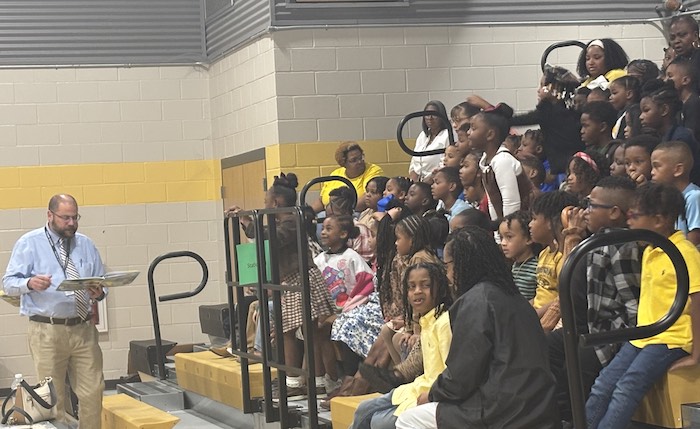Transforming curriculum and learning – developing a subject through a futurist lens – Teacher Magazine

A Case Study in Curriculum Innovation: The “Future Thinking” Initiative and its Alignment with the Sustainable Development Goals
Executive Summary
This report analyzes the “Future Thinking” subject, a Year 9 curriculum initiative at Westbourne Grammar School, as a practical model for implementing Education for Sustainable Development (ESD). The course moves beyond traditional pedagogical models by focusing on future-oriented skills and global challenges, thereby directly contributing to the achievement of multiple Sustainable Development Goals (SDGs), most notably SDG 4 (Quality Education). By equipping students with the tools to analyze and address future trends, the curriculum fosters the competencies required for sustainable development, responsible citizenship, and innovation.
Advancing SDG 4: Quality Education Through a Future-Focused Lens
Rationale for Curriculum Evolution
Traditional educational frameworks, while valuable for teaching historical context, risk preparing students for a world that no longer exists. To address this gap, the “Future Thinking” subject was developed to ensure learning is relevant, purposeful, and authentic. This approach directly supports SDG Target 4.7, which calls for education that equips learners with the knowledge and skills needed to promote sustainable development, sustainable lifestyles, human rights, and global citizenship.
Core Pedagogical Objectives
The subject’s design is intended to challenge, provoke, and inspire students by integrating futures thinking and strategic foresight. Key pedagogical methods and objectives include:
- Critical Analysis: Students analyze diverse multimodal texts (novels, films, podcasts, video games) to understand how narratives shape perspectives on future-focused topics.
- Constructivist Learning: Guided by Thinking Routines and Socratic circles, students collaborate and debate ideas, fostering a deeper, more engaged understanding of complex issues.
- Adaptive Curriculum: Lesson content is continuously updated through horizon scanning to remain current with emerging global trends, ensuring maximum relevance.
- Design Thinking: Students utilize the Design Thinking process to generate innovative ideas and solutions in response to open-ended prompts and speculative questions.
Integration of Multiple SDGs Across Thematic Units
Fostering Sustainable Economic Growth and Innovation (SDGs 8, 9, 11)
The curriculum directly engages with themes central to building a sustainable and innovative future. By exploring these topics, the course prepares students for emerging labor markets and encourages them to envision sustainable societal structures.
- Decent Work and Economic Growth (SDG 8): The course explicitly encourages students to consider “jobs that don’t yet exist,” with many expressing interest in future-proof careers such as game writing, futurism, AI law, and social entrepreneurship.
- Industry, Innovation, and Infrastructure (SDG 9): A core focus on AI, the ethics of technology, and digital-age connections provides students with the foundational knowledge to contribute to future innovation.
- Sustainable Cities and Communities (SDG 11): Students are challenged to reimagine future cities, fostering an understanding of the principles behind sustainable urban development and resilient communities.
Addressing Global Challenges and Promoting Just Societies (SDGs 13, 16)
A significant portion of the curriculum is dedicated to analyzing global megathreats and ethical dilemmas, thereby cultivating a sense of global citizenship and responsibility.
- Climate Action (SDG 13): The course addresses climate change as a critical future trend, with students identifying potential career pathways in climate communication.
- Peace, Justice, and Strong Institutions (SDG 16): Through debates on dystopian futures, the influence of social media, and the development of ethical frameworks for technology, students engage with concepts fundamental to building peaceful, just, and inclusive societies.
Conclusion: A Replicable Model for Education for Sustainable Development
The “Future Thinking” subject at Westbourne Grammar School serves as a compelling case study in how secondary education can evolve to meet the demands of the 21st century and actively contribute to the Sustainable Development Goals. The initiative demonstrates that by shifting focus from the past to the future, educators can create learning environments that not only enhance academic skills but also inspire students to become architects of a more sustainable, equitable, and innovative world. The planned expansion of the program into Year 10 underscores its success and its potential as a replicable model for other educational institutions seeking to embed the principles of ESD into their curricula.
Analysis of Sustainable Development Goals in the Article
1. Which SDGs are addressed or connected to the issues highlighted in the article?
The article on the “Future Thinking” curriculum at Westbourne Grammar School directly addresses and connects to several Sustainable Development Goals (SDGs). The primary focus is on transforming education to be more relevant and forward-looking, which aligns with the core principles of quality education, innovation, and preparing youth for future employment.
- SDG 4: Quality Education: This is the most prominent SDG in the article. The entire initiative is about redesigning curriculum to ensure it is relevant, engaging, and equips students with skills for the future, moving beyond traditional, history-focused teaching methods. The article emphasizes making learning “authentic, purposeful and relevant” to improve student engagement and outcomes.
- SDG 8: Decent Work and Economic Growth: The article connects the new curriculum to students’ future careers. By focusing on “jobs that don’t yet exist” and skills like “Design Thinking,” the school is actively preparing students for the future labor market. It mentions that students have expressed interest in emerging fields like “futurism, climate communication, AI law and social entrepreneurship,” directly linking the educational initiative to future economic participation and decent work.
- SDG 9: Industry, Innovation, and Infrastructure: This SDG is relevant through its focus on innovation. The article presents the “Future Thinking” subject as a “fantastic case study in how curriculum can evolve.” This represents an innovation within the education sector itself. The process of “horizon scanning” and creating an “adaptive and forward-thinking” curriculum is a form of research and development aimed at upgrading the school’s educational “service.”
2. What specific targets under those SDGs can be identified based on the article’s content?
Based on the article’s content, several specific SDG targets can be identified:
-
Target 4.4: By 2030, substantially increase the number of youth and adults who have relevant skills, including technical and vocational skills, for employment, decent jobs and entrepreneurship.
- The article directly supports this target by describing how the “Future Thinking” course develops skills for future careers. It explicitly mentions developing “ideation,” “Design Thinking,” and “written communication” skills. The goal is to “help them develop the skills and mindset to navigate whatever comes their way,” which is the essence of providing relevant skills for future employment.
-
Target 4.7: By 2030, ensure that all learners acquire the knowledge and skills needed to promote sustainable development, including, among others, through education for sustainable development… and global citizenship.
- The curriculum’s focus on “analysing global trends,” “megathreats,” “climate communication,” and “the ethics of love and connection in the digital age” directly contributes to this target. It encourages students to think critically about global challenges and their roles as future citizens, fostering the knowledge needed to promote a sustainable and ethical future.
-
Target 8.6: By 2020, substantially reduce the proportion of youth not in employment, education or training.
- Although the 2020 deadline has passed, the principle of this target is central to the article. By making education more relevant and preparing students for “jobs that don’t yet exist,” the program aims to ensure students are better equipped for post-secondary pathways, thereby reducing the risk of future unemployment or disengagement from education and training.
-
Target 9.5: Enhance scientific research, upgrade the technological capabilities of industrial sectors… encouraging innovation…
- This target is reflected in the school’s approach to curriculum development. The creation of the “Future Thinking” subject is an act of innovation within the educational field. The process of “horizon scanning and staying abreast of emerging developments” to keep the curriculum current is a form of applied research aimed at upgrading the school’s educational offerings.
3. Are there any indicators mentioned or implied in the article that can be used to measure progress towards the identified targets?
Yes, the article mentions and implies several indicators that can be used to measure progress:
- Improved Student Skills: The article explicitly states that a significant learning outcome has been the “development of students’ grammatical expression in authentic contexts” and “improved clarity, precision and voice in their written communication.” These are measurable indicators of skill acquisition (relevant to Target 4.4).
- Student Career Aspirations: A clear indicator mentioned is that “several students have expressed interest in pathways connected to film, digital ethics, communications, politics and storytelling” and careers in “game writing, futurism, climate communication, AI law and social entrepreneurship.” Tracking the number and type of future-oriented career interests expressed by students serves as an indicator for Targets 4.4 and 8.6.
- Curriculum Innovation and Adaptation: The successful design, implementation, and evolution of the “Future Thinking” subject is an indicator in itself. The plan to “grow Future Thinking even further, positioning it as a subject in year 10” is a concrete measure of the program’s success and the school’s commitment to innovation (relevant to Target 9.5).
- Engagement with Global Issues: The curriculum requires students to analyze “global trends,” “megathreats,” and “future-focused topics.” Student performance in summative assessments, where they write analytically on these topics and their “real-world relevance,” can be used as an indicator to measure their acquisition of knowledge for sustainable development and global citizenship (relevant to Target 4.7).
4. Summary of Findings
| SDGs | Targets | Indicators |
|---|---|---|
| SDG 4: Quality Education |
4.4: Increase the number of youth with relevant skills for employment and entrepreneurship.
4.7: Ensure all learners acquire knowledge and skills for sustainable development and global citizenship. |
– Development of students’ communication skills (clarity, precision, voice). – Students’ ability to use Design Thinking and ideation. – Students’ analytical writing on global trends, megathreats, and ethics. – Student performance on summative assessments analyzing real-world relevance of future-focused topics. |
| SDG 8: Decent Work and Economic Growth | 8.6: Reduce the proportion of youth not in employment, education or training. |
– Number of students expressing interest in future-oriented career pathways (e.g., AI law, futurism, climate communication). – Development of skills identified as crucial for future jobs (e.g., adaptability, critical thinking, creativity). |
| SDG 9: Industry, Innovation, and Infrastructure | 9.5: Enhance research and upgrade technological capabilities, encouraging innovation. |
– The creation and implementation of the new “Future Thinking” curriculum. – The continuous, adaptive process of updating course content based on “horizon scanning.” – The planned expansion of the innovative program to an additional year level (Year 10). |
Source: teachermagazine.com

What is Your Reaction?
 Like
0
Like
0
 Dislike
0
Dislike
0
 Love
0
Love
0
 Funny
0
Funny
0
 Angry
0
Angry
0
 Sad
0
Sad
0
 Wow
0
Wow
0












































































